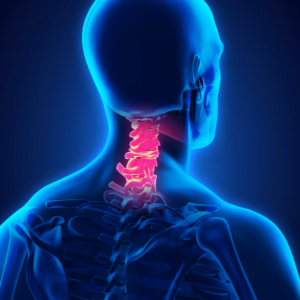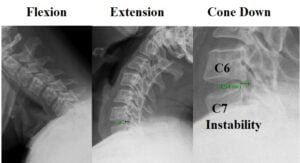Introduction
The cervical spine, consisting of seven vertebrae, plays a crucial role in supporting the head’s weight, facilitating motion, and protecting the spinal cord. Cervical instability, characterized by excessive motion or laxity within the cervical spine, can result from various causes and contribute to significant morbidity. This essay aims to delve into the multifaceted aspects of cervical instability, emphasizing its etiology, pathogenesis, clinical manifestations, diagnostic modalities, and treatment options, with a primary focus on prolotherapy as a potential intervention.
Causes of Cervical Instability
- Trauma : Traumatic injuries, such as whiplash-associated disorders, can cause cervical ligamentous laxity and instability. These injuries often result from motor vehicle accidents or sports-related incidents.
- Degenerative Changes : As individuals age, the cervical spine may undergo degenerative processes, including disc degeneration, facet joint arthritis, and ligamentous laxity, contributing to instability.
- Congenital Factors : Some individuals may be born with structural abnormalities or connective tissue disorders that predispose them to cervical instability.
- Inflammatory Conditions : Autoimmune diseases like rheumatoid arthritis can lead to inflammation and destruction of cervical ligaments, potentially causing instability.
Pathogenesis of Cervical Instability
The pathogenesis of cervical instability involves the disruption of the delicate balance between the cervical spine’s supportive ligaments, muscles, and bones. Trauma, degeneration, or congenital factors can compromise this balance, resulting in increased cervical mobility and hypermobility at certain segments. Over time, these changes can lead to chronic pain, neurological deficits, and a decreased quality of life.
Symptoms of Cervical Instability
The clinical presentation of cervical instability can vary widely among individuals. Common symptoms include:
- Neck Pain : Persistent, often debilitating neck pain is a hallmark of cervical instability.
- Headaches : Cervicogenic headaches, stemming from instability-related neck issues, are prevalent among patients.
- Radicular Symptoms : Compression of cervical nerves due to instability can result in radiating pain, tingling, or numbness in the arms and hands.
- Muscle Weakness : Instability can lead to muscle weakness in the neck and upper extremities.
- Limited Range of Motion : Patients may experience a reduced range of motion in the neck, impacting daily activities.
- Coordination and Balance Issues : Severe cervical instability may cause problems with balance and coordination.
Diagnosis of Cervical Instability
Accurate diagnosis is critical for effective management. Diagnostic methods include:
- Clinical Evaluation : A thorough physical examination, including neurological assessments, is essential to identify specific symptoms and deficits.
- Imaging Studies : X-rays, MRI scans, and CT scans can reveal structural abnormalities, ligamentous laxity, or instability-related changes.
- Dynamic Imaging : Flexion-extension radiographs can assess cervical spine instability by evaluating segmental motion.
- Electrodiagnostic Testing: Electromyography (EMG) and nerve conduction studies can identify nerve involvement and assess muscle function.
Treatment Options for Cervical Instability
- Conservative Management : Physical therapy, activity modification, and cervical bracing may be recommended for mild cases.
- Medications : Non-steroidal anti-inflammatory drugs (NSAIDs) and muscle relaxants can help manage pain and muscle spasms.
- Surgical Intervention : For severe cases or when conservative measures fail, surgical procedures such as cervical fusion or stabilization may be considered.
- Prolotherapy : Prolotherapy, or regenerative injection therapy, is gaining attention as a potential treatment for cervical instability. This technique involves injecting a proliferative solution, often containing dextrose, into damaged ligaments and tendons, stimulating tissue repair and strengthening.
Prolotherapy for Cervical Instability
Recent research has investigated the role of prolotherapy in cervical instability management. Studies have shown promising results regarding pain reduction, functional improvement, and ligamentous strengthening. For instance, a study by Hauser et al. (2020) found significant pain relief and increased cervical stability in patients with chronic neck pain after prolotherapy treatment.
Conclusion
Cervical instability is a complex condition with diverse causes and symptoms that can significantly impact a patient’s quality of life. Accurate diagnosis and appropriate treatment are essential for effective management. Prolotherapy, as a regenerative injection therapy, shows promise in addressing cervical instability by strengthening damaged ligaments and reducing pain.
We AT ALLEVIATE have helped numerous people suffering with cervical instability ,with Image guided platelet rich plasma with prolotherapy for the cervical facet joints and the ligaments supporting the cervical spine resulting in great reduction in severity of symptoms, improvement in function and and a significantly better quality of life.






